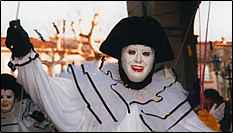Carnival
in Switzerland
By
Thomas Krauss
In Switzerland the carnival activities include colorful processionals and masked balls in several cities. Most carnivals are held after Lent begins, a historical Protestant reaction to Catholicism. Festivities usually start a week before Ash Wednesday.
In Lucerne, on the Rhine, bordering France and Germany, the tradition harks back to medieval times; costumes, especially masks, tend to be hideous to frighten away the devil.
 |
| photo by Michel Pichard |
Activities start early on the Monday morning following Ash Wednesday. As the clock strikes 4 a.m., street lights are switched off and costumed fife-and-drum bands begin playing, their head-lanterns swinging through the darkened streets. Next come the "Cliquen", or carnival cliques, wearing costumes such as pigs' heads, grotesque caps, and giant leering faces that represent specific themes. Each group is illuminated by transparent, shouldered lanterns, most of which are over three meters (10 feet) high. The procession is repeated on Monday and Wednesday afternoons, and in the evenings small groups wander from bar to bar, singing and acting out events of the past year. Tuesday evening brings the "Guggemuusige", or masked musicians, who fill the streets with improvised music on brass and percussion instruments. The bands move haphazardly to stop and mix with the crowds. On Wednesday night the carnival climaxes with the "Gdssle", a wild romp through the city center . Masked people wander through the narrow streets, following the pipers and drummers until 4 a.m. Thursday morning.
Basel's "Fasnacht" is the country's biggest carnival, involving about 20,000 masked participants who march through the streets in three huge processions.
Solothurn's torchlight parade begins at 5 a.m. on the Thursday before Ash Wednesday, with participants wailing away on brass and percussion instruments while wearing nightshirts and nightcaps. The following afternoons are marked by masked balls, street parades of "fools", and the torching of the "Bvvgg", or straw man.
On Carnival Monday in Zug, a traditional carnival figure named Greth Schnell parades through the streets with a basket on her back as the story goes, to put her drunken husband in and carry him home. She is accompanied by seven colorful "fools" who hand sweets to the children as they call out her name.
During Carnival in the valley of Lvtschental, young people assume the leathery faces of carved carnival masks and pass from village to village, frightening and playing pranks on passersby. This custom derives from an ancient belief in evil, grimacing-faced spirits that lived in soot-covered chimneys.
The Roitschdggdtd tradition or wearing of masks, is mainly done in Wiler, where competitions for the best masks are held on the Saturday afternoon during Carnival.